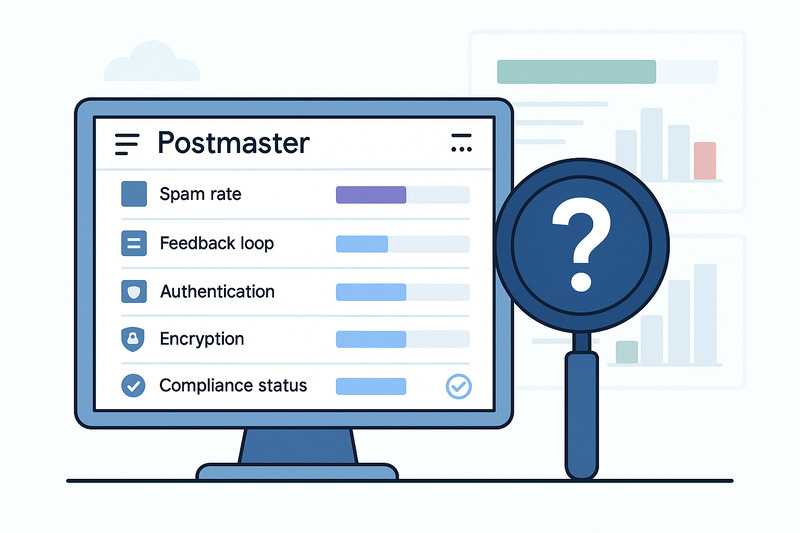On September 30, 2025, Google flipped an important switch. Two of the most-watched dashboards inside Postmaster Tools, Domain Reputation and IP Reputation, disappeared overnight. These charts were the closest thing senders had to seeing how Gmail perceived their mail. A green bar meant your messages were trusted; a red one meant you’re in trouble.
Now, those bars are history. Postmaster v2 has officially taken over, and the only thing clearer than the new interface is what’s missing from it. For anyone managing inbox performance, this update was the kind of surprise that made them stop mid-scroll and think, “Well, that’s going to change everything.”
In this article, we will explore what this change means for you as a sender, what deliverability will look like from now on, and what you can do to keep it in good shape.
Key takeaways:
Google’s September 2025 Google Postmaster Tools update removed Domain Reputation and IP Reputation dashboards, ending direct visibility into Gmail’s trust signals.
Here’s what you need to know now:
- Reputation data is gone. Gmail still uses it internally, but you can’t see it anymore.
- Postmaster v2 focuses on compliance metrics like spam rate, authentication, and feedback loops.
- Deliverability analysis now relies on engagement behavior and placement testing. The change marks a new era of deliverability that will involve less scorekeeping and more behavioral insight.
Why did Google do it?
![]()
There’s a reason Google retired those dashboards, and it’s not because reputation isn’t important anymore. It’s because the way Gmail measures it has outgrown those static charts.
A decade ago, an IP address told Gmail almost everything it needed to know about a sender. If a server had a clean record, good mail got through. If it didn’t, you were out of luck. But the ecosystem changed. Today, deliverability is decided by thousands of micro-signals: engagement, authentication, domain history, spam complaint patterns, and more.
In that kind of environment, a single green or red bar doesn’t say much. To Google, it started being a distraction from a simpler time that encouraged people to chase “good reputation” badges instead of delivering on consistency and user experience.
There’s also the privacy angle. Platforms everywhere are steadily cutting back the amount of diagnostic data they expose. Apple did it with Mail Privacy Protection. Meta and TikTok have been doing it with targeting data. Google’s decision fits the same pattern: less raw insight, more abstraction, more algorithmic judgment.
It’s frustrating, yes, but it also makes sense. Gmail’s spam filtering has become a living system, adapting in real time to each sender’s behavior. Static dashboards simply couldn’t keep up.
What Postmaster Tools v2 shows now
Open the new Postmaster dashboard, and you’ll notice it’s cleaner, but also emptier. The v2 version shows what Google calls the core signals of healthy email programs: spam rate, feedback loop, authentication, encryption, and the new compliance status panel.
Here’s what they mean:
- Spam rate shows how many users are flagging your messages
- Feedback loop gives aggregated complaint data for high-volume senders.
- Authentication confirms that your SPF, DKIM, and DMARC records are implemented.
- Encryption shows whether mail travels securely end-to-end.
There’s also the newest addition, compliance status, which tells you whether your sending practices align with Gmail’s bulk sender guidelines.
It’s all useful data. But without the old Google Postmaster Domain Reputation and IP Reputation charts, Postmaster Tools is just observational. You can see the outcome, not the cause. Your spam rate might increase, but you won’t know if that’s because Gmail lost trust in your domain, throttled a specific IP, or noticed an engagement drop.
The v2 API won’t change that either. It’ll modernize the structure, add batch endpoints, and clean up authentication, but it won’t bring back visibility into Gmail’s trust signals.
Postmaster Tools has officially moved from a performance analysis platform to a compliance monitor. It tells you if you’re breaking the rules, not how your deliverability is holding up.
The practical fallout for senders
If you’ve ever managed deliverability, you know how much those two dashboards anchored your sanity. When engagement dropped or spam complaints rose, you’d open Postmaster, glance at your Domain Reputation, and instantly know whether Gmail had cooled on you. That reference point is now gone.
Diagnosing problems has turned into guessing. When open rates drop, you can’t just check whether Gmail flagged your domain. You’re left putting it together from indirect clues like engagement and complaint spikes, authentication logs, or subtle changes in send volume (kind of like your only thermometer and trying to gauge the fever by touch)
For ESPs, agencies, and high-volume senders, this is more than an inconvenience. It changes workflows. Postmaster Tools used to validate hunches; to confirm whether an IP pool was burning out or a shared domain needed to cool off. Without that validation, people are forced to lean on placement tests, seed accounts, and reputation heuristics to infer what Gmail’s systems are doing in the background.
Even customer communication becomes trickier. When a client asks, “Why are my emails landing in Promotions all of a sudden?”, there’s no official metric to point to anymore. You can explain best practices and monitor engagement, but Gmail’s trust score is now invisible.
Email deliverability is moving into a new phase where consistent testing, audience behavior, and message interaction are way more important than any dashboard ever was.
If you’re watching your Gmail performance deteriorate and aren’t sure why, start running placement tests with InboxAlly. It’s the easiest way to see how inboxes are handling your messages after Google’s update.
InboxAlly for email deliverability
When the environment changes, those in it simply adapt. The insight Google just removed is exactly what platforms like InboxAlly have been building toward for years.
Where Postmaster Tools gave you reputation scores, InboxAlly shows you outcomes. It measures how inbox providers treat your messages, not what they say about you. Every interaction from subscribers feeds back into the system: which folder your email lands in, how it’s opened, how it’s engaged with, and whether any of that changes over time. That’s behavioral data drawn straight from the inbox itself.
InboxAlly works by observing. When Gmail stops telling how much it trusts your domain, InboxAlly can still show you how it behaves. You see how your reputation works in practice, whether your campaigns are consistent, lean into Promotions, or Spam.
It also helps you notice patterns that reputation dashboards couldn’t do anyway: timing effects, content sensitivity, list health, and the gradual changes that happen long before metrics fall off a cliff.
So, the value isn’t in replacing Google’s charts but in going deeper than they ever went. Postmaster told you what Gmail thinks. InboxAlly shows you what Gmail does.
A new phase for email deliverability
Losing Gmail’s reputation dashboards changes how senders measure success, but it doesn’t make deliverability impossible. The focus now goes to understanding patterns rather than going after a score.
For many senders, this is the moment to refine how they monitor inbox performance and interpret behavior instead of static data.
At InboxAlly, we’ve been helping senders adapt to these changes for years by showing how mailbox providers handle their messages. If you’re rethinking how to track performance after Google’s update, book a free demo and see how behavioral insight can replace the visibility that just disappeared.


